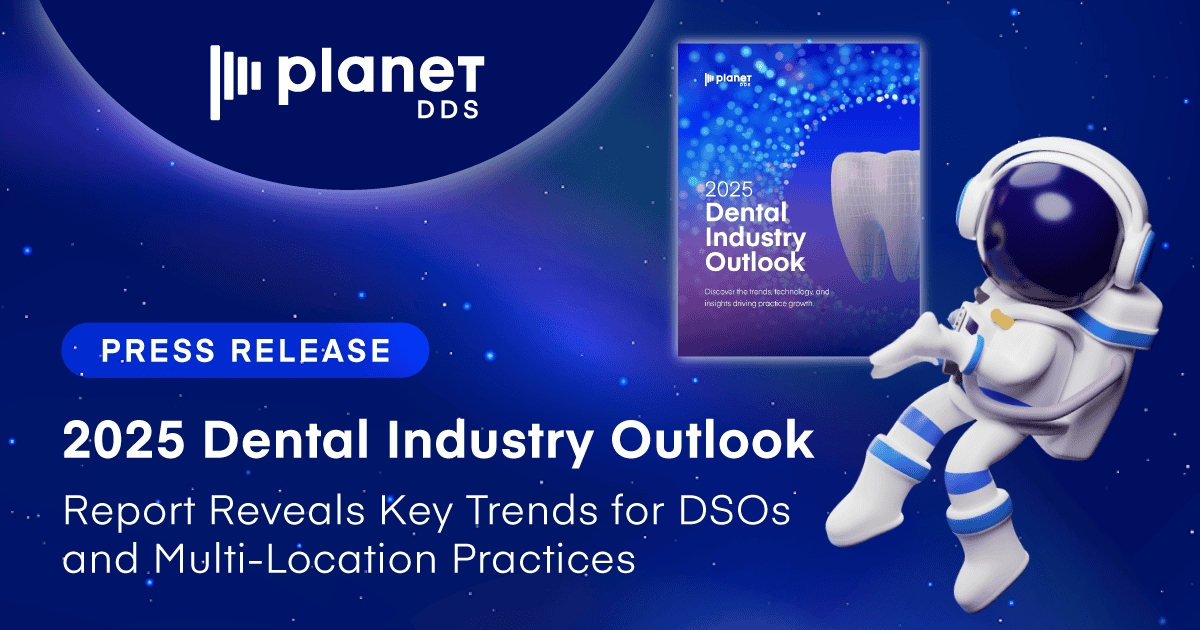Creative Ways DSOs Are Solving the Revenue Cycle Management (RCM) Challenge

This article was written by Planet DDS staff and originally published on Group Dentistry Now.
Revenue Cycle Management (RCM) is all about getting paid for the services your dental practices provide.
Historically, it’s been labor intensive, and there’s room for human error at just about every stage.
Here is how sophisticated, cloud-based practice management systems are incorporating automation, workflow tools, reporting, and analytics to help DSOs improve their RCM processes and increase collections.
Automating RCM and Integrating Workflow Tools to Increase Efficiency
“Top RCM priorities of DSOs include automation, greater access to insurance information, and integrated workflow tools. These are key to solving efficiency challenges and driving a positive patient experience,” said Jeremy Serfling, a revenue strategy expert with more than 20 years of experience working in fintech. He joined Planet DDS as a senior product manager in 2023 and leads the Denticon team developing and integrating revenue cycle management solutions.
DSOs have partnered with Denticon, DentalXChange, and more tech-savvy companies to streamline eligibility verification and claims processing, accelerate payments, and reduce the risk of human error. That’s become especially important as dental practices face turnover and staffing shortages.
Patients want to know what their insurance carrier will cover, and what will be their out-of-pocket cost. Dentists want to ensure claims are submitted properly so they can be paid quickly and accurately for the services they provide.
Here are some of the innovative ways practices are using software solutions like Denticon to improve the RCM process:
- Eligibility Verification: Denticon’s integrated workflow with DentalXChange, a dental insurance clearinghouse that transmits EDI (electronic data interchange) transactions including eligibility and claim remittance information. That reduces the amount of time dental practice team members spend on the phone with insurance carriers.
- Multi-location Management: Since Denticon is a cloud-based practice management solution, team members can view data offsite as long as they have permission-based access.
- Tiered Fee Schedules: Team members can update a fee schedule once and assign it to the correct plan, office, and provider. This drives efficiency and ensures fee schedule consistency.
- Integrated Images Attachments: This capability eliminates the need for screenshots or switching between windows.
- Electronic Claim Submission: Team members can validate and submit claims from within the practice management system, which eliminates the need for team members to log into a third-party website to submit claims.
- Claims Task Manager: Denticon’s built-in workflow to manage outstanding claims, including task assignment to other team members, eliminates the need for spreadsheets, sticky notes, and emails, which team members have traditionally used to track claims.
- Convenient Patient Ledger: With one click, team members can see how payments were allocated across providers and offices, which makes it very easy to explain to the patient what has been paid and what is still owed.
- 835/ERA Auto-Posting Payments: With this feature, payments are auto-posted to the ledger which eliminates the need for manual insurance payment entry. Team members can also access the digital Explanation of Benefits (EOBs) which allows for more efficient follow-up on claim denials.
- RCM Reporting: Denticon comes standard with robust RCM reporting to provide you with actionable insights. All reports can be generated by group or by office, which makes it ideal for multilocation practices. These insights enable practice leaders to quickly identify and fix problems.
- Text and Email Payment Reminders: With enhanced services such as Denticon Pay, practices can send manual or automated text messages and email reminders to patients, giving them an easy way to pay online.
Payer Relations: Credentialing, Fee Negotiation, Fee Schedule Management
The RCM process typically encompasses two parts: payer relations and practice operations.
“One of the reasons why dental insurance is so confusing is because it’s not insurance in the traditional sense. Instead, it’s a benefit plan,” said Victoria Johnson, the founder of Top Tier Practice Solutions and an RCM expert who has worked in DSOs for 14 years. “It’s the employer’s choice in dental benefits plans that determines the percentage of the cost that the patient needs to pay out-of-pocket.”
Dental practices and groups negotiate fees with the insurance carriers. They negotiate what percent they’ll discount their UCR fees (usual, customary, and reasonable charge), which is what a cash-paying patient would pay, in exchange for the insurance company referring in-network patients to them.
Those negotiated fees are represented systematically through Fee Schedules. DSOs can have hundreds of Fee Schedules in their practice management system, one for each insurance plan they accept.
“When the practice receives back the Explanation of Benefits, it shows what you billed the insurance company according to your UCR, what the insurance carrier paid, which is the negotiated fee, and what is the difference between them,” said Johnson. “If the patient is correctly assigned to the correct fee schedule in your practice management system, then you receive from the insurance company what you expected to receive, and your ledger will balance out. If you attached the patient to the wrong fee schedule, then the amount will be off, and you need to write off the difference or bill the patient.”
Revenue Cycle Management Operations: Insurance Verification, Claim Submissions, Billing and Collections
The second part of the RCM process is operations.
This is the part that is most prone to human error. There are typically six core processes involved: eligibility verification, claim submission, claim follow-up, payment posting, denial management, and patient payment collection.
Most Common RCM Mistakes with Manual Processes
- Patient scheduling and registration errors: Team members may transpose the insurance subscriber ID numbers, spell the patient’s name incorrectly, enter the wrong date of birth. All of these prevent the clearinghouse from being able to match the patient’s information entered by the dental practice with the patient’s information in the insurance carrier’s system.
- Insurance verification errors: It can take up to 30 minutes per patient for a practice to call an insurance carrier and confirm benefits. Insurance verification software companies are trying to automate this process, but it’s difficult to ensure 100% coverage because the data in the carriers’ systems is not well-organized and easily accessed. Each carrier has multiple dental insurance plans with varying rules for things like waiting periods for major procedures, types of materials that can be used, and treating pre-existing conditions such as missing teeth.
- Incorrect coding: The service must be walked out and charged out correctly, with the proper dental codes, and those must match what is submitted to the insurance carrier.
- Incorrect fee schedule: Common mistakes include not updating the fee schedule in your practice management system to reflect negotiated rates and/or assigning the patient to the wrong fee schedule.
- Insufficient documentation of services provided: All major procedures need supporting documentation, including X-rays of the teeth involved and a written narrative. Practice management systems such as Denticon provide a comprehensive workflow that includes native integration with Apteryx dental imaging software.
- Delaying claim submissions: Dental team members should submit claims on the same day as the service electronically, not through fax or mail.
- Not collecting co-pays: The patient’s out-of-pocket fees depend on the type of policy the patient’s employer has negotiated with the dental insurance company. Team members should always collect the patient’s portion at the time of service. Third-party financing solutions such as CareCredit, Sunbit, or iCreditWorks can help patients afford the cost of their care.
- Delaying payment processing and posting: When the insurance carrier issues payment, dental team members should enter payment amount and information to the ledger and deposit the payments in the bank on the same day so everything matches. Adopting the 835 process can automate much of the insurance payment entry and expedite bank deposits through Electronic Funds Transfer (EFT).
- Not following up on denials and appeals: Sophisticated practice management systems such as Denticon enable team members to instantly access aging reports across all offices, which can help you prioritize the claims that require more immediate follow-up. The task manager provides an integrated workflow for managing the tasks to resolve outstanding claims. When an insurance claim is delayed or denied, it’s typically because the carrier is requesting additional information in order to determine whether the procedure was medically necessary.
Top Tips for Effective RCM Management for DSOs
Implementing a comprehensive, consistent, and transparent revenue cycle management system includes well-defined standard operating procedures and ongoing training.
Since many doctors are paid based on collections, it’s important to ensure the payment is posted to the correct procedure by the correct provider so the doctor’s compensation is accurate. Victoria Johnson shares these tips:
- Standardize the end-of-day process
- Assign a team member to ensure all claims are submitted for procedures performed that day.
- Confirm that all EOBs and payments from insurance carriers have been allocated to the correct patient and the correct provider.
- Run a day sheet that shows your cash, your credit card payments, and everything that was posted, then close out physical checks, cash, and credit card payments to ensure everything matches.
- Go to the bank to deposit that day’s collections.
- Cross-train team members so if the person who typically handles RCM responsibilities is out, somebody else can step in.
- Look in your office drawers to ensure no one has accidentally put aside checks from patients or insurance carriers.
“It’s crazy how much money you can find in some practices,” said Victoria Johnson. “I know of one time when an office manager went out on vacation, and nobody went to the bank until she came back. Checks totaling tens of thousands of dollars were just sitting there in a drawer, instead of being deposited in the bank.”
With proper RCM processes, practice management software automation, and cross-trained staff members, it’s easy to ensure your dental group is following best practices and increasing collections and profitability.
To learn how Denticon’s practice management system makes RCM easier, click here to schedule an overview with a technology solution expert.



